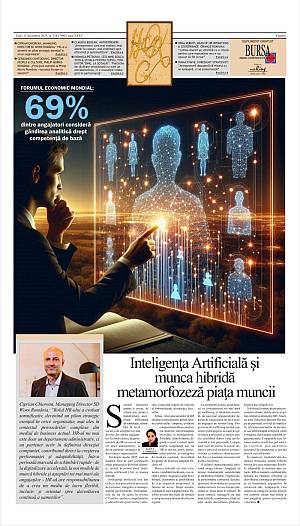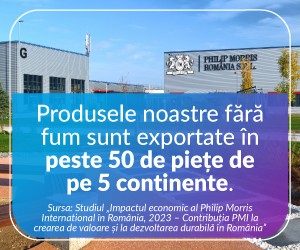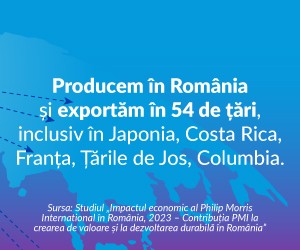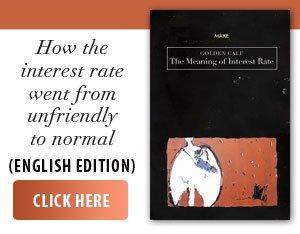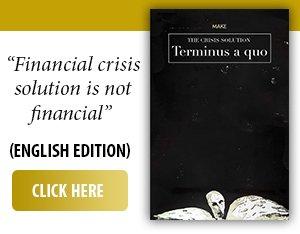The construction sector is one of the main contributors to the creation of the Gross Domestic Product, but it is currently facing problems generated by the bureaucracy from the central and local public authorities, lending from the banking sector and the capital market, the reduction of some fiscal facilities and due to the lack of qualified labor force, stated yesterday, the participants of the conference Development - from planning to stability and sustainability, an event organized in partnership by the National Bank of Romania and the Employers' Association of Construction Designers.
At the opening of the conference, Mugur Isărescu, the governor of the National Bank of Romania, showed that the construction sector represents in our country a major component of economic growth and that the financial situation of this sector is an important indicator of the general state of the national economy.
Marcel Boloş, the Minister of Finance stated that the Government recently approved a 500 million euro funding scheme for the construction sector and added: "We have a huge budget for development, we are talking about 75 billion euro from the European funds allocated through the National Resilience Plan and Recovery and through cohesion policy, money that will finance plans and investments that we cannot afford to miss even if we have to make consistent efforts to see them through, even if the current budget deficit creates problems for us. The PNRR has a very important investment component, but it also has a regime of institutional reforms that we must complete, reforms that concern a deep reduction in budget expenditures, a reduction that will lay the foundations for Romania's modernization. In parallel, from the public budget, we have a development budget managed by the Ministry of Development, Public Works and Administration and a budget for investments from national funds, as well as the Anghel Saligny national program, which is very important for rural infrastructure, infrastructure that represents a component essential for Romania's long-term development. The three pillars of today's debate - planning, stability and sustainability - make Romania a country that, at the end of the implementation of all the programs and projects started, will have a modern and competitive face in Europe, thanks to the modern infrastructure necessary to attract investors and develop of long-term projects".
The Minister of Investments and European Projects, Adrian Câciu, stated that our country has left the paradigm of poverty and entered the paradigm of development, but noted that, unfortunately, mentalities have not yet changed in certain areas of the public administration and the environment private. His Majesty mentioned that this year the value of the submitted projects would amount to 40 billion euros on the cohesion policy and that he hopes that of this amount, approximately 29 billion euros will be contracted by December 31, 2024.
Minister Adrian Câciu said: "The National Recovery and Resilience Plan has two major components: investments and reforms. The reforms are necessary to remedy the structural problems and stop the waste of public money. From the PNRR, we must receive the two components, 28.5 billion euros, but we currently have a contract of 36 billion euros, of which 21 billion euros represent the PNRR component. If we make these investments, the quality of economic growth changes, it will be a sustainable growth and we will have a guarantee of the multiplication of these investments in the economy, multiplication which will lead to higher budget revenues. Regarding the cohesion policy, we have an allocation of 46 billion euros, money that must be spent until the end of 2027 or - if there is an extension - until the end of 2029. We have submitted projects of 32 billion euros for the cohesion policy. Our objective for the end of 2024 is that of these 32 billion euros - we hope that by December 31, 2024 we will have submitted projects of 40 billion euros - at least 29 billion euros will be contracted this year and of the contracted amount 5 billion euros will be reimbursed to Romania".
• Financial envelope of 150 billion euros for investments from public funds
The Minister of European Investments and Projects showed that our country has come out of the paradigm of lack of projects and lack of funding, that we can practically talk about an inflation of projects and funding, but we really need administrative capacity and personnel for the rapid implementation of everything projects submitted and approved for financing.
Adrian Câciu mentioned: "The total envelope of investments committed at this moment by Romania amounts to 150 billion euros - investments only from public funds - and at the end of their implementation we must have a different national economy, much more developed than in the present".
Adrian Veştea, the Minister of Development, Public Works and Administration, showed that at the moment there is no locality in our country that does not have at least one project financed by European funds.
The Minister of Development specified: "It is a large infusion of capital. Indeed, there are many stages until implementation, but we want to simplify this period at least in terms of the procurement procedure. Anghel Saligny is the largest investment program, and 3109 administrative-territorial units have ongoing contracts. We can say that on this program, only those who did not apply do not have projects. The program is being developed for the implementation of objectives related to water infrastructure, sewerage, methane gas, but also road infrastructure. Another component that we are financing concerns seismic grade buildings and we have several projects that will actually go into implementation. As for the projects carried out on PNDL 1 and 2, they have a degree of completion of 90%".
Adrian Veştea also said that the projects financed from PNRR, financing managed through MDLPA, amount to a total value of 7 billion euros and mentioned that all the net investments made last year by the ministry amount to 183.6 billion lei.
However, the Minister of Development specified: Romania must create a strategy regarding the capacity to implement these projects. The speed of implementation is increasing because it is competing with the development of the world economy. The human resource is essential, and the fiscal part is marginal, because we have a very large investment volume. We must take into account that we still have 28 or 29 months in which we must have 36 billion euros, most of them from the PNRR, already invested. That is why we need to support the growth of the construction sector, which is an important contributor to the Gross Domestic Product.
• Banking sector and capital market ready to support construction companies
Regarding the financing of construction companies, Florin Danescu, executive president of the Romanian Banks Association, stated that first of all, a state of trust must be created between entrepreneurs and banks, so that banks are no longer seen only as institutions whose the goal is to make a profit.
Florin Dănescu said: "In general, few people criticized the banks for not being competent, but there are many who complain that the banks are not reliable. I've found the same thing happens in other industries. There is a perception of banks that profits are very high, but out of 24 industries we are 20th in return on capital. The banking industry is far below average. (...) Romania's economy can be seen from two points of view: a positive one, according to which we are in a historical moment of development, and a negative one, through the lens of the long road we have to travel. What is the actual situation? 540,000 SMEs provide 67% of jobs and contribute to the formation of 56% of GDP, being the main pillar of the national economy. However, we must see that, from a quantitative point of view, we are in last place in the European Union, with 24 SMEs per 1000 inhabitants. Then we have a structural problem, because 35% or almost 40% of SMEs have negative capital for more than 10 years, and this share is a worrying one. There are also problems from a qualitative point of view, as long as with regard to the productivity calculated in relation to the salary, we have an average figure of 14,500 euros per year per employee compared to the European average which amounts to 57,000 euros per year".
Regarding the financing of construction companies by the capital market, Gabriela Horga, vice president of the Financial Supervisory Authority with responsibilities in the field of the capital market, stated that more companies in this activity sector need to be listed on the stock exchange in order to get the funding they need.
Gabriela Horga stated: "The promotion and development of the construction industry is vital for economic growth and sustainable development. The construction industry has had a dynamic development in recent years through public investments and through access to European funds, but it is a growing sector that has not been bypassed by the increase in the prices of construction materials and which faces an acute need for financing. Fortunately, financing can cover several alternatives. Beyond the banking sector, we need to look at the capital market financing that several companies have turned to. The capital market does not compete with bank loans, but is complementary. More construction companies are listed on the stock exchange and I think it is becoming a medium and long-term goal for construction firms to use the instruments offered by the capital market for financing. In addition to this, I think there is also a need for a campaign to educate SMEs to understand the rules and capital market mechanisms and to gain confidence in their use. (...) One such tool is real estate crowd-funding, a field in which ASF has authorized two companies that facilitate the granting of these financings for real estate developers. Unfortunately, in real estate crowdfunding companies do not benefit from the protection of compensation funds. (...) In any case, the economy needs an increase in the number of investors and the diversification of instruments for the capital market to become a growth engine for companies".
• 4 billion euros from pension funds, unused on the capital market
For his part, Adrian Tănase, general director of the Bucharest Stock Exchange, stated that the BET index is at historical highs and means that a good period will follow from an economic point of view.
The BVB representative stated: "Unfortunately, we are not where we want to be with the stock exchange, that is, we are not represented in the local economy. The value of all companies listed on the BSE is 15% of GDP and we would like to be comparable to Poland which has a value of 30% of GDP, not to mention developed markets where the value of listed companies is higher than GDP. So there is still a lot to do, but the trajectory is very good. In this context, we also have certain frustrations, and one of them is a sectoral representation that we don't really want. We want a different sectoral representation and one of the sectors that is attracting our attention and we are trying to identify solutions to make it better represented on the stock exchange is the real estate and construction sector. At the moment, the real estate sector represents only 2% of the BVB. We saw that the construction sector represents 8% of GDP, but we have not yet reached this percentage of representation in the stock market. We basically have only two developers that are listed on the BSE. There are solutions that we should discuss with the associations in the field, but of course education is needed. Entrepreneurs in the field may not know the capacity of BVB and the money that exists, that is available in the capital market, but there are also new tools that we need to introduce to facilitate the transmission of available money from the capital market to the construction sector. For example, local private pension funds have a 15% investment limit in public-private infrastructure projects, a limit that is not used at all because there are no such infrastructure projects. 15% now means almost 4 billion euros, which co-financed could finance very large infrastructure projects. We are now working to regulate the Real Estate Investment Trust, an instrument that facilitates investment in the real estate sector for individual investors and institutional investors through the capital market, under much more advantageous conditions of discipline and transparency, which will lead to the creation of a pool of buyers for the respective constructions ".
Regarding the above interventions, Cristian Erbaşu, the president of the Federation of Construction Societies Patronages showed that the financing crisis is a problem faced by this sector, for which the tax facilities granted to employees were reduced, although these facilities had a total annual value under one billion euros, given that the constructions annually bring to the state budget 5 billion euros only from European funds.
Cristian Erbaşu also said: "Money is hard to come by and even harder to come by, and builders have to give guarantees of 10%, 15% or 20% of the value of the work. (...) Regarding productivity, we are at 80-90% of the European average and we believe that in our country the construction sector must exceed 10% of GDP, not 8% as it is now. Another major problem we face is bureaucracy. We are in a generalized gridlock created by bureaucracy, which is causing us staffing problems. Instead of keeping people on site, we keep them in the office working on the same kind of paperwork. We currently have a ratio of two people in the office to one man on site. And the central authorities are talking about simplification. Unfortunately, with each simplification so far we have actually witnessed a complication, because new rules were made but the old ones remained in force".
The representative of the construction contractors also said that the labor crisis is also a problem, which will bring with it a steep increase in the workforce, as long as the companies practice "hard hunting" for the same people whose salaries are increased to the detriment of productivity.





















